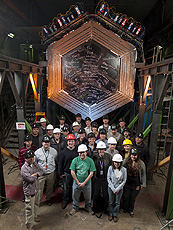Meet MINERvA: a blend of particle and nuclear physics
 |
|
The MINERvA experiment at Fermilab observes neutrino interactions.
|
When I say I work at Fermilab, most people assume I work on one of the Tevatron experiments. When I tell them that I work with neutrinos instead, a lot of people still aren’t familiar with the MINERvA experiment. So, since this is our collaboration’s first official contribution to Fermilab’s blog on Quantum Diaries this year, I’d like to introduce you to our small but awesome experiment.
MINERvA is a neutrino detector the sits in the NuMI beam – the most intense beam of neutrinos in the world and the same beam that’s currently used by MINOS and that will soon be used by NOvA. In fact, MINERvA sits right in front of the MINOS near detector, in a cavern about 330 feet below ground. The detector itself is, among other things (See paragraph five), basically a big hunk of plastic — many thousands of long thin strips of a special kind of plastic that generates light when charged particles pass through it. When neutrinos from the NuMI beam enter MINERvA, a few of them interact with the nuclei that make up the MINERvA and we detect the products of these interactions through the light they produce.
MINERvA is what’s called a neutrino-scattering experiment. Basically, this means our goal is to understand how neutrinos interact with ordinary matter. Because neutrinos interact so weakly, this is much less understood than you might think — it’s really hard to get enough neutrino interactions to make precise measurements. But thanks to the huge numbers of neutrinos from the NuMI beam and the precision of the detector, MINERvA is part of a new era of neutrino physics when precise measurements are becoming possible.
So, why do we want to better understand neutrino interactions? There are lots of neutrinos in the universe, and understanding what happens when they collide with matter is interesting in its own right, but there are also a lot of other reasons we’d like to understand neutrino scattering. For instance, experiments looking for exotic neutrino phenomena such as mass oscillations are plagued by large uncertainties associated with how likely neutrinos are to interact with nuclei. Input from MINERvA will decrease those uncertainties, and because the energy of the NuMI beam is near the optimum for studying neutrino oscillations, our measurements will be particularly useful to oscillation experiments.
Read more
|